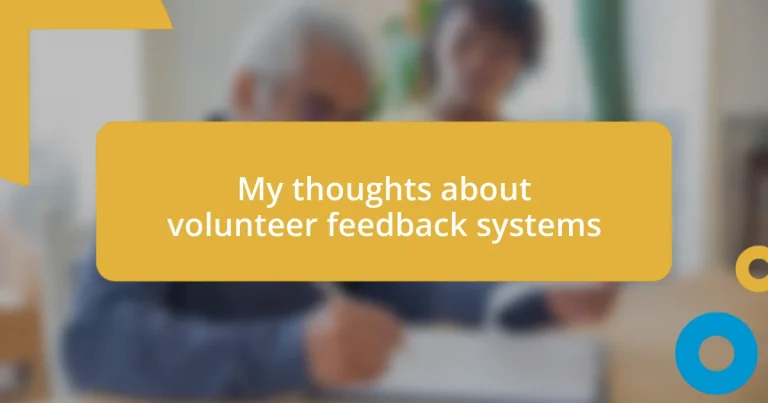Key takeaways:
- Implementing a robust volunteer feedback system fosters a culture of continuous improvement, enhances volunteer retention, and creates a sense of community.
- Key features of effective feedback include timeliness, specificity, anonymity options, actionable insights, and two-way communication to encourage meaningful contributions.
- Measuring the impact of feedback involves analyzing both quantitative and qualitative data, tracking follow-up actions, and creating an ongoing dialogue to ensure volunteers feel their voices matter.
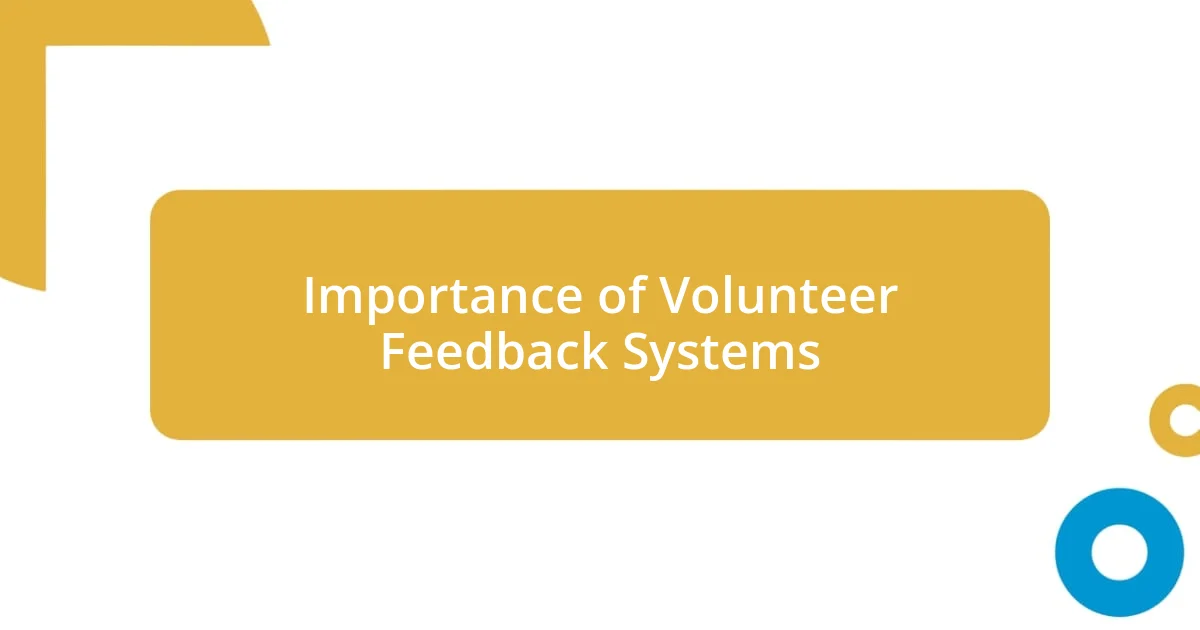
Importance of Volunteer Feedback Systems
When I think about volunteer feedback systems, I can’t help but recall my own experiences as a volunteer. Often, after dedicating my time to a cause, I felt a deep desire to share my thoughts on how things could be improved. By implementing a robust feedback system, organizations can tap into these insights, fostering a culture of continuous improvement that makes everyone feel valued.
Have you ever finished a volunteer shift and wondered if your contributions truly mattered? That’s where feedback systems come in. They ensure volunteers feel heard, which not only boosts morale but also enhances retention. When volunteers know their voices are influential, it transforms their experience into something meaningful and personal, making them more likely to return.
Additionally, feedback systems provide organizations with invaluable direction. When volunteers share their perspectives, it allows management to identify strengths and weaknesses within their programs. Just think about it—how much more effective could initiatives be if they were shaped by the very people who carry them out? Ultimately, these systems bridge the gap between volunteers and organizations, creating a stronger, more unified community focused on shared goals.

Key Features of Effective Feedback
When I reflect on effective feedback, I realize that clarity is essential. Volunteers need to understand what information to provide and how it will be used. In my experience, when feedback forms are clear and concise, volunteers are more likely to share honest, valuable insights. Without that clarity, participants might feel lost or hesitant to contribute.
Here are some key features that can enhance feedback systems:
- Timeliness: Gather feedback soon after an event to capture fresh perspectives.
- Specificity: Encourage detailed responses, allowing for a thorough understanding of experiences.
- Anonymity Options: Offering a chance for anonymous feedback can lead to more honest sharing.
- Actionable Insights: Ensure volunteers know how their feedback influences future decisions.
- Two-Way Communication: Create platforms where volunteers can not only give feedback but also engage in discussions about it.
I remember attending a workshop where feedback was collected immediately afterward. The facilitators made it a point to ask for specific examples of what worked and what didn’t. That openness not only encouraged everyone to share but also laid the foundation for meaningful conversations that followed. I left feeling my opinions mattered, and I could see the changes being implemented based on our collective feedback. It made the experience feel collaborative, motivating me to stay engaged with the organization long after the workshop ended.
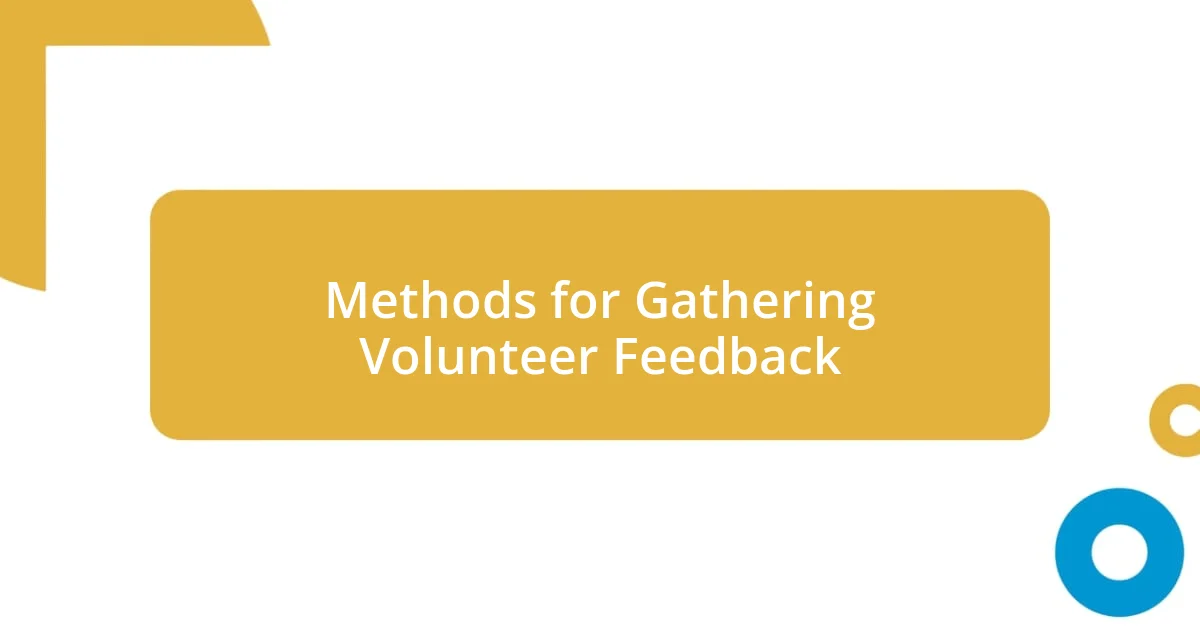
Methods for Gathering Volunteer Feedback
Gathering feedback from volunteers can be approached in various ways, each with its own advantages. For instance, surveys can be a powerful tool for collecting insights. I remember organizing a survey after a community outreach program. The responses poured in, revealing not only logistical flaws but also highlighting unexpected successes. That feedback helped shape future events and made volunteers feel their input was genuinely valued, reinforcing their commitment.
In-person interviews can also be incredibly effective. I recall a time when my organization opted to have one-on-one conversations post-event. It was an eye-opener. Volunteers opened up about their experiences more freely than they would have in a written format. There’s something about face-to-face dialogue that fosters connection. It encourages volunteers to share their emotions and thoughts in depth, painting a clearer picture of their journey and contributions.
Another method worth considering is focus groups. These allow for dynamic discussions and varied perspectives. During one group session, I witnessed how volunteer interactions led to brainstorming some innovative solutions to common challenges. The passion and enthusiasm in the room were palpable, reminding me that collaboration often breeds the best ideas. Each of these methods showcases the importance of actively engaging with volunteers and ensuring their voices are not only heard but celebrated.
| Method | Advantages |
|---|---|
| Surveys | Allows for wide-reaching insights; easy to analyze quantitatively. |
| In-Person Interviews | Encourages deeper emotional insights; builds rapport. |
| Focus Groups | Fosters collaboration; generates innovative ideas through discussion. |
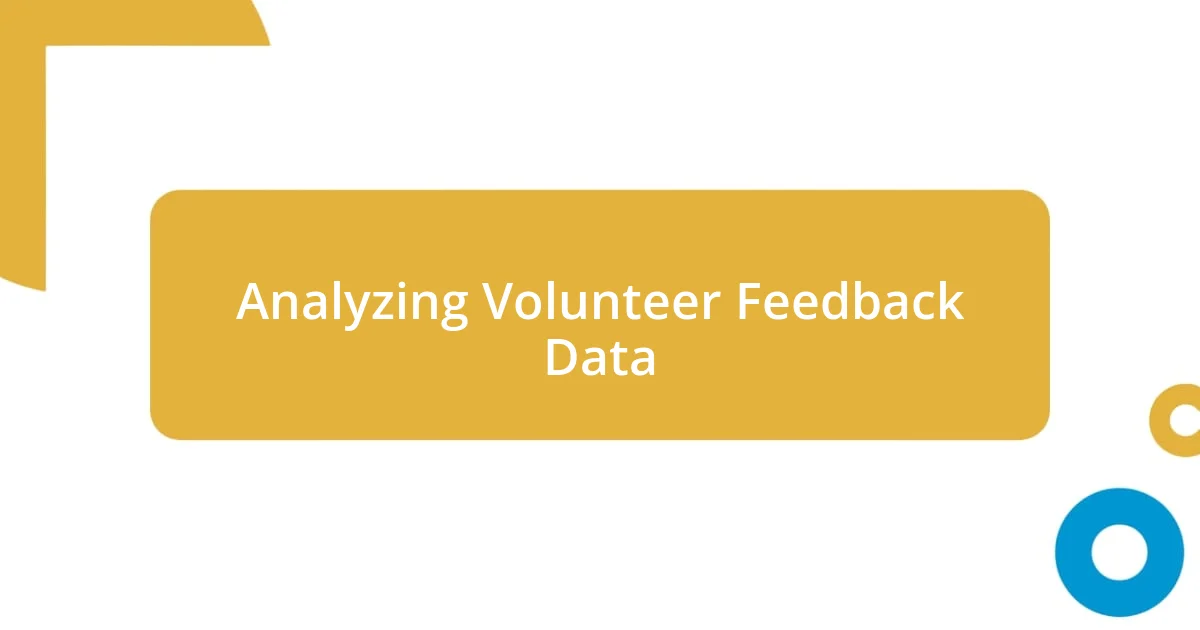
Analyzing Volunteer Feedback Data
Analyzing volunteer feedback data can feel like piecing together a puzzle. I find it fascinating to dive into the nuances behind the collected responses. For instance, while reviewing survey results from a recent event, I noticed patterns that illuminated not only the surface issues but also the deeper sentiments of volunteers. Have you ever found surprising insights hidden in feedback that made you rethink your approach? I certainly have, and those moments can be truly enlightening.
When I step back to analyze the data, I like to focus on both quantitative and qualitative responses. Numbers can reveal trends, but personal stories can bring those numbers to life. In one analysis, I paired graphical data with verbatim quotes from volunteers. It created a compelling narrative that showcased our strengths and areas for improvement more vividly than charts alone ever could. I often wonder, how can we ensure these stories are shared beyond the analysis phase? It’s crucial to circulate these insights with the entire team, fostering a culture of transparency and growth.
I also emphasize the importance of making sense of the feedback as a collaborative effort. After conducting a thorough analysis, I convened a meeting with team members to brainstorm actionable steps based on our findings. That open dialogue sparked innovative solutions, and I distinctly remember the buzz of excitement in the room. It struck me how crucial it was to not just collect feedback but to actively engage with it. Have you tried such an approach in your organization? It’s a game changer when everyone feels involved in shaping the future based on shared insights.

Implementing Changes Based on Feedback
Implementing changes based on volunteer feedback is a crucial step in fostering a supportive environment. I remember a time when we received constructive criticism about our training sessions. Instead of brushing it off, we took the time to revamp the content, integrating specific suggestions. The difference was palpable. Not only did volunteers respond positively, but their engagement levels skyrocketed during the next round of training. It reinforced my belief that when volunteers see their input lead to real change, they feel more invested.
One significant lesson I’ve learned is the value of transparency in this process. After the feedback review, I shared with the volunteers exactly how their insights influenced our decisions. That openness cultivated a deep sense of trust and belonging within the group. I often ask myself, how many organizations miss out on this bond simply because they don’t communicate their actions effectively? It’s so vital that volunteers know their voices matter, and sharing the outcomes of their feedback can transform a simple suggestion into a powerful motivator.
Change doesn’t happen overnight, though, and patience is key. I recall proposing the gradual rollout of new initiatives based on feedback. When volunteers saw small, incremental changes, their enthusiasm grew, and so did their willingness to share even more ideas. That iterative feedback loop became invaluable, allowing us to continuously adapt and improve. Isn’t it interesting how a simple cycle of listening, implementing, and then listening again can lead to a transformative impact on the volunteer experience?
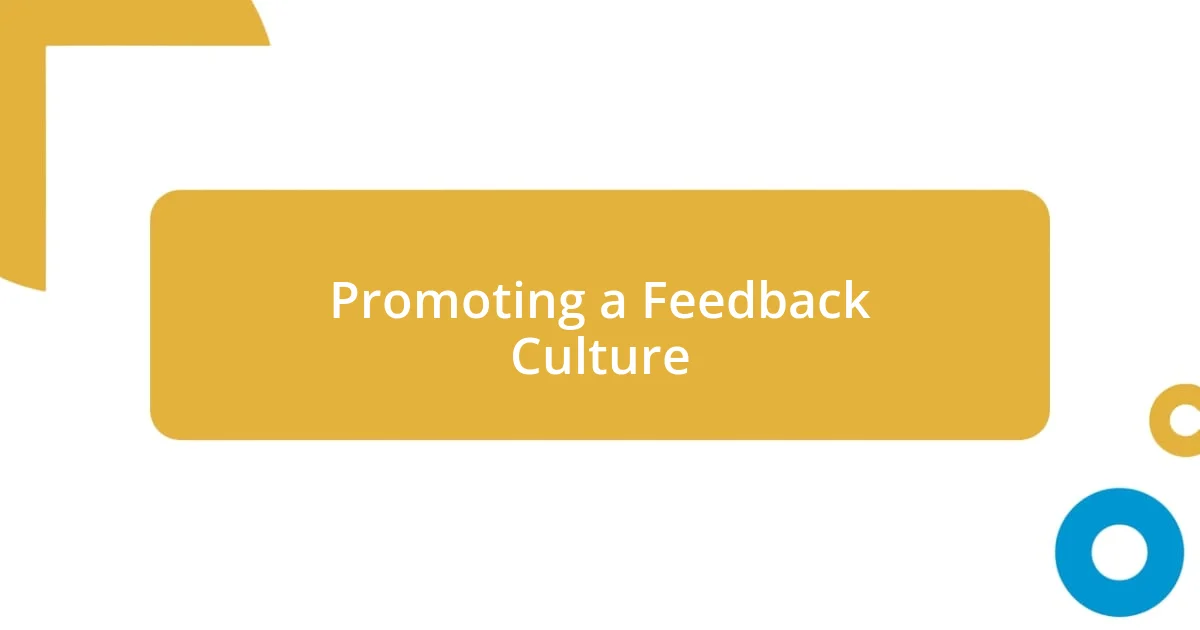
Promoting a Feedback Culture
Building a feedback culture is all about creating an environment where every voice is valued. I recall a time when we organized a casual feedback session after an event. Instead of the usual formalities, we sat in a circle with coffee in hand, and the conversation flowed naturally. The atmosphere felt safe, and many volunteers shared their thoughts openly. It made me realize that when feedback feels less like an obligation and more like a conversation, people are much more willing to share honestly. Have you noticed how relaxed conversations often yield deeper insights?
I believe it’s essential to encourage regular feedback, not just during evaluations or surveys. One initiative I introduced was a “feedback wall” where volunteers could post comments or suggestions any time. The energy shifted dramatically. I often found myself stopping to read the posts and reflect on the community’s sentiments. This ongoing dialogue not only kept the lines of communication open but also fostered a sense of collective ownership. Isn’t it empowering to see your ideas displayed for everyone to consider?
Moreover, celebrating feedback successes can amplify your culture even further. I made it a point to highlight examples of changes made from volunteer suggestions during our team meetings. When volunteers realized their contributions had tangible impacts, it ignited a fire in the group. I distinctly remember one volunteer’s face lighting up as I shared how their idea led to a successful outreach event. Moments like that exemplified the connection between feedback and meaningful action, reinforcing that feedback isn’t just heard—it drives real change. Does your team recognize and celebrate those small victories? I’ve found that doing so can transform a simple feedback exchange into a powerful motivator for continued input and collaboration.
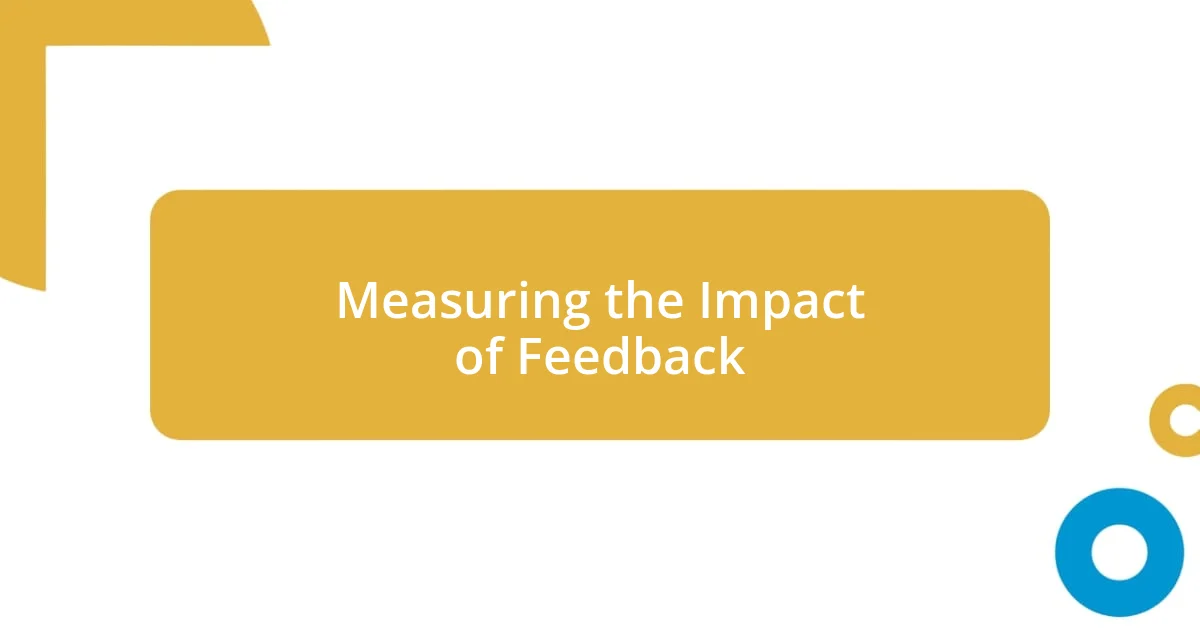
Measuring the Impact of Feedback
Measuring the impact of feedback is often more nuanced than one might think. I remember an instance where we implemented a survey after a large volunteer event. Initially, we focused solely on quantitative metrics, like volunteer satisfaction scores. However, I quickly realized those numbers, while helpful, didn’t capture the whole picture. By diving into qualitative responses, I unearthed some heartfelt stories that truly reflected the volunteers’ experiences. Have you ever noticed how the stories behind the numbers can reveal deeper insights into what really matters?
Another important aspect is tracking follow-up actions. In my experience, when we revisited specific feedback weeks later to evaluate the changes made, it showed our volunteers that we genuinely cared about their input. I implemented a system where we documented changes alongside related feedback, and volunteers loved it. They experienced their suggestions coming to life firsthand. Isn’t it gratifying when volunteers can directly correlate their feedback with tangible outcomes? It not only reinforces their sense of belonging but also catalyzes more constructive dialogue in the future.
I’ve also seen the powerful role of comparison in this process. After asking the same volunteers for input across different projects, we analyzed their responses over time. I was fascinated to see shifts in trust and enthusiasm with each successive project. It reminded me that measuring impact isn’t a one-time event; it’s an ongoing journey. How often do we reflect on previous feedback cycles? Taking the time to contrast different phases can illuminate real growth areas and inspire collective progress, creating an environment where feedback thrives and evolves.












